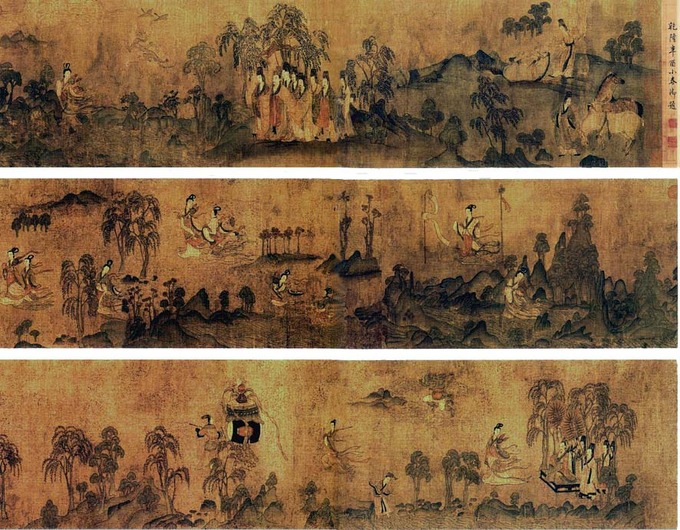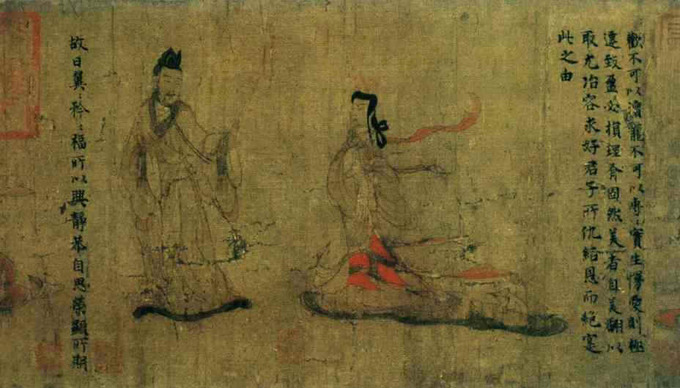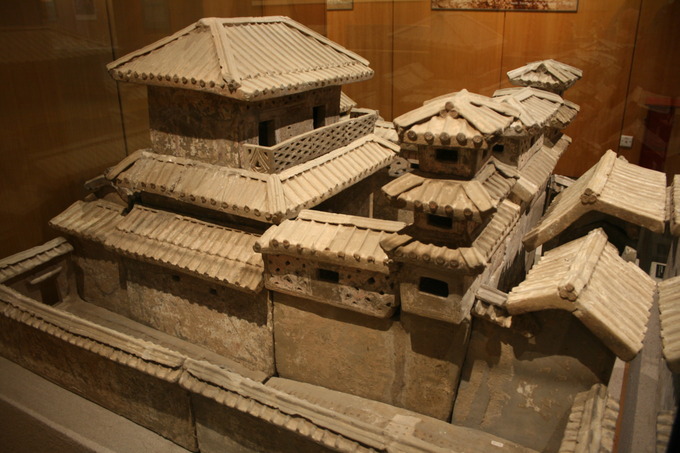23.6: The Six Dynasties Period
- Page ID
- 53027
Painting during the Six Dynasties Period
During the Six Dynasties period (220–589 CE), people began to write about art and appreciate painting for its own beauty.
Learning Objectives
Summarize the Six Principles of painting according to Xie He and draw a timeline of the eras within the Six Dynasties
Key Takeaways
Key Points
- The Six Dynasties period takes its name from the six ruling dynasties of the era: the Eastern Wu (222–280), Jin (265–420), Liu Song (420–479), Southern Qi (479–502), Liang (502–557), and Chen (557–589) Dynasties.
- Individual artists began to rise to attention, such as Gu Kaizhi. Many illustrated Confucian moral themes—such as the preferred behavior of a wife to her husband or of children to their parents—with gracefully drawn figures.
- Xie He—a writer, art historian, and critic in 5th century China—is most famous for outlining six points to consider when judging a painting, taken from the preface to his book, The Record of the Classification of Old Painters.
- Xie He’s six elements include: 1) Spirit Resonance, 2) Bone Method, 3) Correspondence to the Object, 4) Suitability to Type, 5) Division and Planning, and 6) Transmission by Copying.
Key Terms
- vitality: Energy or vigor.
- Confucian: One who follows the teachings of Confucius.
The Six Dynasties period (220–589 CE) takes its name from the six ruling dynasties of the era: the Eastern Wu Dynasty (222–280), Jin Dynasty (265–420), Liu Song Dynasty (420–479), Southern Qi Dynasty (479–502), Liang Dynasty (502–557), and Chen Dynasty (557–589). During the Six Dynasties period, people began to write about art and appreciate painting for its own beauty. Individual artists began to rise to attention, such as Gu Kaizhi.
Many illustrated Confucian moral themes—such as the preferred behavior of a wife to her husband or of children to their parents—with gracefully drawn figures.

Luoshenfu, Gu Kaizhi (344-406 CE): The painting Luoshenfu by artist Gu Kaizhi, painted during the Six Dynasties Period.
The Six Principles
Xie He—a writer, art historian, and critic in 5th century China—is most famous for outlining six points to consider when judging a painting. These were taken from the preface to his book, The Record of the Classification of Old Painters, written circa 550 CE. According to him, the six elements that define a painting are:
- Spirit Resonance, or vitality , which refers to the flow of energy that encompasses theme, work, and artist. Xie He said that without Spirit Resonance, there was no need to explore a painting further.
- Bone Method, or the way of using the brush, which refers not only to texture and brush strokes, but also to the close link between handwriting and personality. In his day, the art of calligraphy was inseparable from that of painting.
- Correspondence to the Object, or the depicting of form , which includes shapes and lines .
- Suitability to Type, or the application of color, which includes layers, value , and tone .
- Division and Planning, or placing and arrangement, which corresponds to composition , space , and depth.
- Transmission by Copying, or the copying of models, which means not only from life but also from works of antiquity .

Tomb mural: Murals from a tomb of the Six Dynasties period (550-577 CE) in Jiuyuangang, Xinzhou, showing a rural hunting scene on horseback.
Calligraphy during the Six Dynasties Period
The calligraphic tradition of East Asia originated in China and greatly advanced during the Six Dynasties period.
Learning Objectives
Describe the evolution of Chinese calligraphy from ancient China to the Six Dynasties
Key Takeaways
Key Points
- Chinese calligraphy is an artistic writing form widely practiced and revered in the Sinosphere , which includes China, Japan, Korea, and Vietnam.
- The various styles of calligraphy adhere to general standards. Chinese calligraphy and ink and wash painting are closely related, accomplished using similar tools and techniques.
- In ancient China, painting and calligraphy were the most highly appreciated arts in court circles. They were done almost exclusively by amateurs, aristocrats, and scholar-officials who had the leisure to perfect the technique.
- Invented in the 1st century, paper gradually replaced silk as the backdrop for calligraphy. Original writings by famous calligraphers have been highly valued throughout China’s history and are mounted on scrolls and hung on walls like paintings.
- Some of the most famous Chinese calligraphers, including Wang Xizhi, lived during the Six Dynasties period.
- Wang Xizhi’s most famous work is the Lanting Xu, the preface to a collection of poems written by a number of poets who gathered at Lan Ting, near the town of Shaoxing in Zhejiang province.
Key Terms
- literati: A person who engages in critical study, thought, and reflection about the reality of society.
- sinosphere: Areas and countries that have been heavily influenced by Chinese culture.
- soot: Fine black or dull brown particles of amorphous carbon and tar produced by the incomplete combustion of coal or oil.
- ink and wash painting: An East Asian type of brush painting of Chinese origin that uses the same black ink as in East Asian calligraphy; also known as literati painting.
Background: Calligraphy and Ancient China
Calligraphy, a visual art related to writing, is the design and execution of lettering with a broad tip brush or other instrument. The calligraphic tradition of East Asia originated in China and is widely practiced and revered in the Sinosphere (a designation that often includes China, Japan, Korea, and Vietnam). The various styles of calligraphy in the tradition adhere to a general standards. Chinese calligraphy and ink and wash painting are closely related, as they are accomplished using similar tools and techniques. Chinese painting and calligraphy are distinguished from other cultural arts because they emphasize motion and tend to be charged with dynamic life.
In ancient China, painting and calligraphy were the most highly appreciated arts in court circles; they were done almost exclusively by amateurs, aristocrats, and scholar-officials who had the leisure to perfect the technique and sensibility necessary for great brushwork. Calligraphy was considered the purest form of painting. The implements included the brush pen made of animal hair and black inks made from pine soot and animal glue. Writing and painting were done on silk, gradually replaced after the invention of paper in the 1st century. Original writings by famous calligraphers have been valued throughout China’s history; they are mounted on scrolls and hung on walls as paintings are.

Palace Lady detail from Admonitions of the Instructress to the Palace Ladies: In ancient China, painting and calligraphy were the most highly appreciated arts in court circles; they were done almost exclusively by amateurs, aristocrats, and scholar-officials who had the leisure to perfect the technique and sensibility necessary for great brushwork.
Calligraphy during the Six Dynasties
Some of the most famous Chinese calligraphers lived during the Six Dynasties period. The Six Dynasties refers to the dynasties during the periods of the Eastern Wu Dynasty (222–280), Jin Dynasty (265–420), Liu Song Dynasty (420–479), Southern Qi Dynasty (479–502), Liang Dynasty (502–557), and Chen Dynasty (557–589).
Wang Xizhi and the Lanting Xu
One of these famous calligraphers was Wang Xizhi, who lived during the 4th century CE in the middle of the Jin Dynasty. His most famous work is the Lanting Xu, the preface to a collection of poems written by a number of poets who gathered at Lan Ting near the town of Shaoxing in Zhejiang province. Wang Xizhi was traditionally referred to as the Sage of Calligraphy and is considered one of the most esteemed Chinese calligraphers of all time and a master of all forms, especially the running script. The Emperor Taizong admired his works greatly. In addition to the Wang Xizhi’s esteem in China, he has been and remains influential in Japanese calligraphy.
The Lantingji Xu is a famous work of calligraphy by Wang Xizhi composed in the year 353 CE. Written in semi-cursive script, it is among the best-known pieces of calligraphy in Chinese history and is often copied. This work began as the preface to a seminal collection of Chinese nature poetry but developed a life of its own. The preface describes an event during that year’s Spring Purification Festival in which 42 literati , including Xie An and Sun Chuo, were present at a gathering at the Orchid Pavilion near Shaoxing, Zhejiang, at which they composed poems, played music, and enjoyed wine. The preface consists of 324 Chinese characters in 28 lines . The character zhī (之) appears 20 times, but no two appearances look the same, a feature that constitutes calligraphic excellence. This celebrated work of literature flows rhythmically and gave rise to several Chinese idioms .

Main text of a Tang Dynasty copy of Wang Xizhi’s Lantingji Xu, by Feng Chengsu.: Throughout Chinese history, many copies were made of the Lantingji Xu, which described the beauty of the landscape around the Orchid Pavilion and the get-together of Wang Xizhi and his friends. The original is lost; however, some believe it was buried in the mausoleum of Emperor Taizong of Tang. This Tang copy made between 627-650 CE is considered the best of the copies that has survived.
Architecture during the Six Dynasties Period
The Six Dynasties (220-589 CE) in Chinese history was a time of great advancements in architecture.
Learning Objectives
Characterize the architecture and art of the Six Dynasties
Key Takeaways
Key Points
- The Six Dynasties generally includes the periods of the Three Kingdoms (220–280 CE), the Jin Dynasty (265–420 CE), and the Southern and Northern Dynasties (420–589 CE).
- By the 6th century, Buddhism had spread with tremendous momentum throughout China and dramatically influenced Chinese architecture.
- Although multiple-story towers such as guard towers and residential apartments existed in previous periods, it was during this time that the Chinese transformed the rounded earthen mound of the stupa into the towering pagoda to house the sacred buried relics of Buddha at its core.
- The Songyue Pagoda, built in 523, is the oldest extant pagoda in China; its unique many-sided shape may represent an early attempt to merge the Chinese architecture of straight edges with the circular style of Buddhism from the Indian subcontinent.
- Although mostly only ruins of brick and rammed earth walls and towers from the Six Dynasties have survived, information on ancient Chinese architecture can be discerned from realistic clay models of buildings created as funerary items.
- The Jin Dynasty was particularly known for miniature models of buildings used to decorate the tops of “soul vases” and for its celadon porcelain wares.
Key Terms
- celadon: Ceramic ware with a pale green glaze.
- ensemble: A group of separate things that contribute to a coordinated whole.
Background: The Six Dynasties
The Six Dynasties is a collective term for six Chinese dynasties during the periods of the Three Kingdoms (220–280 CE; also known as the Eastern Wu or the Cao Wei), the Jin Dynasty (265–420 CE), and the Southern and Northern Dynasties (420–589 CE), which included the Liu Song, Southern Qi, Liang, and Chen Dynasties. During this time, the Chinese people made great advancements in architecture.
Architecture in the Six Dynasties
By the 6th century, Buddhism had spread with tremendous momentum throughout China, and Chinese culture was adjusting and adapting its traditions to include Buddhism worship. This also had a profound influence on architecture. Although multiple-story towers such as guard towers and residential apartments existed in previous periods, the distinct Chinese pagoda tower (used for storing Buddhist scriptures) evolved during the Six Dynasties period from the stupa, which came from Buddhist traditions of protecting sutras in ancient India. The Chinese transformed the rounded earthen mound of the stupa into the towering pagoda to house the sacred buried relics of Buddha at its core.
The Songyue Pagoda, built in 523, is the oldest extant pagoda in China, enduring primarily because it was constructed from brick instead of wood. The unique many-sided shape of the Songyue Pagoda may represent an early attempt to merge the Chinese architecture of straight edges with the circular style of Buddhism from the Indian subcontinent. The perimeter of the pagoda decreases as it rises, as seen in Indian and Central Asian Buddhist cave temple pillars and the later round pagodas in China.

Songyue Pagoda: A circular-based stone-constructed Buddhist pagoda built in 523 CE during the Southern and Northern Dynasties period of the Six Dynasties. It is the oldest existent stone Chinese pagoda. Earlier wooden Chinese pagodas have not survived.
Funerary Models
Tombs of members of the ruling Xiao family, with sculptural ensembles in various states of preservation , are located near Nanjing. The best surviving example of a monumental statuary from the Liang Dynasty is the ensemble of the Tomb of Xiao Xiu (475–518 CE), a brother of Emperor Wu, located in Qixia District east of Nanjing.
Although mostly only ruins of brick and rammed earth walls and towers from the Six Dynasties have survived, information on ancient Chinese architecture (especially wooden architecture) can be discerned from realistic clay models of buildings created as funerary items. These depicted miniature versions of Six Dynasties architecture. Throughout the Six Dynasties, miniature models of buildings or entire architectural ensembles were made to decorate the tops of “soul vases” (hunping) found in many tombs of that period. In addition to illustrating architecture, jar designs often incorporated animal and Buddhist figures.

Eastern Wu artwork depicting architecture: A green-glaze ceramic jar from the Three Kingdoms (or Eastern Wu) period with human figures, birds, and architecture, on display in the Nanjing Museum.

Jar of the Western Jin: Jar designs of the Jin Dynasty often incorporated architectural designs as well as animal and Buddhist figures.
Advances in Technology
Technology advanced significantly during the relatively short Three Kingdoms (220-280 CE) period, including in the realm of architecture. Shu chancellor Zhuge Liang invented the wooden ox, an early form of the wheelbarrow, and improved on the repeating crossbow. Wei mechanical engineer Ma Jun is considered the equal of his predecessor Zhang Heng. He invented a hydraulic-powered mechanical puppet theater for Emperor Ming of Wei; square-pallet chain pumps for irrigation of gardens in Luoyang; and the ingenious design of the South Pointing Chariot, a non-magnetic directional compass operated by differential gears.

Pottery Palace: Though from the Han Dynasty (c. 2nd century BCE – 2nd century CE), this pottery palace provides a good example of pottery created for elite burial that illustrates the architecture of the time.
- Curation and Revision. Provided by: Boundless.com. License: CC BY-SA: Attribution-ShareAlike
- Tomb_of_Northern_Qi_Dynasty_in_Jiuyuangang%2C_Xinzhou%2C_Mural_02.jpg. Provided by: Wikipedia. Located at: en.Wikipedia.org/wiki/Six_Dynasties#/media/File:Tomb_of_Northern_Qi_Dynasty_in_Jiuyuangang,_Xinzhou,_Mural_02.jpg. License: Public Domain: No Known Copyright
- Luoshenfu Gu Kai Zhi. Provided by: Wikipedia. Located at: en.Wikipedia.org/wiki/File:Luoshenfu_Gu_Kai_Zhi.jpg. License: Public Domain: No Known Copyright
- Chinese painting. Provided by: Wikipedia. Located at: en.Wikipedia.org/wiki/Chinese_painting%23Sui_and_Tang_dynasties_.28581.E2.80.93907.29. License: CC BY-SA: Attribution-ShareAlike
- Six Dynasties. Provided by: Wikipedia. Located at: en.Wikipedia.org/wiki/Six_Dynasties. License: CC BY-SA: Attribution-ShareAlike
- Song Dynasty. Provided by: Wikipedia. Located at: en.Wikipedia.org/wiki/Song_Dynasty. License: CC BY-SA: Attribution-ShareAlike
- vitality. Provided by: Wiktionary. Located at: en.wiktionary.org/wiki/vitality. License: CC BY-SA: Attribution-ShareAlike
- Confucian. Provided by: Wiktionary. Located at: en.wiktionary.org/wiki/Confucian. License: CC BY-SA: Attribution-ShareAlike
- LantingXu. Provided by: Wikipedia. Located at: en.Wikipedia.org/wiki/File:LantingXu.jpg. License: Public Domain: No Known Copyright
- Nvshizhentu. Provided by: Wikipedia. Located at: en.Wikipedia.org/wiki/File:Nvshizhentu.jpg. License: Public Domain: No Known Copyright
- Chinese calligraphy. Provided by: Wikipedia. Located at: en.Wikipedia.org/wiki/Chinese_calligraphy. License: CC BY-SA: Attribution-ShareAlike
- Chinese art. Provided by: Wikipedia. Located at: en.Wikipedia.org/wiki/Chinese_art%23Calligraphy. License: CC BY-SA: Attribution-ShareAlike
- Lantingji Xu. Provided by: Wikipedia. Located at: en.Wikipedia.org/wiki/Lantingji_Xu. License: CC BY-SA: Attribution-ShareAlike
- Wang Xizhi. Provided by: Wikipedia. Located at: en.Wikipedia.org/wiki/Wang_Xizhi. License: CC BY-SA: Attribution-ShareAlike
- Boundless. Provided by: Boundless Learning. Located at: www.boundless.com//art-history/definition/sinosphere. License: CC BY-SA: Attribution-ShareAlike
- soot. Provided by: Wiktionary. Located at: en.wiktionary.org/wiki/soot. License: CC BY-SA: Attribution-ShareAlike
- JinJar. Provided by: Wikipedia. Located at: en.Wikipedia.org/wiki/File:JinJar.JPG. License: Public Domain: No Known Copyright
- Eastern_Wu_green_glaze_pottery_jar_%28top%29.JPG. Provided by: Wikipedia. Located at: en.Wikipedia.org/wiki/Eastern_Wu#/media/File:Eastern_Wu_green_glaze_pottery_jar_(top).JPG. License: Public Domain: No Known Copyright
- Pottery palace 1. Provided by: Wikipedia. Located at: en.Wikipedia.org/wiki/File:Pottery_palace_1.JPG. License: CC BY-SA: Attribution-ShareAlike
- 800px-Songyue_Pagoda_1.JPG. Provided by: Wikipedia. Located at: en.Wikipedia.org/wiki/Songyue_Pagoda#/media/File:Songyue_Pagoda_1.JPG. License: CC BY-SA: Attribution-ShareAlike
- Six Dynasties poetry. Provided by: Wikipedia. Located at: en.Wikipedia.org/wiki/Six_Dynasties_poetry. License: CC BY-SA: Attribution-ShareAlike
- Funerary art. Provided by: Wikipedia. Located at: en.Wikipedia.org/wiki/Funerary_art%23China. License: CC BY-SA: Attribution-ShareAlike
- Chinese architecture. Provided by: Wikipedia. Located at: en.Wikipedia.org/wiki/Chinese_architecture. License: CC BY-SA: Attribution-ShareAlike
- Nanjing. Provided by: Wikipedia. Located at: en.Wikipedia.org/wiki/Nanjing%23Culture_and_art. License: CC BY-SA: Attribution-ShareAlike
- Six Dynasties. Provided by: Wikipedia. Located at: en.Wikipedia.org/wiki/Six_Dynasties. License: CC BY-SA: Attribution-ShareAlike
- Three Kingdoms. Provided by: Wikipedia. Located at: en.Wikipedia.org/wiki/Three_Kingdoms. License: CC BY-SA: Attribution-ShareAlike
- Southern and Northern Dynasties. Provided by: Wikipedia. Located at: en.Wikipedia.org/wiki/Southern_and_Northern_Dynasties%23Culture. License: CC BY-SA: Attribution-ShareAlike
- Jin Dynasty (265-420). Provided by: Wikipedia. Located at: en.Wikipedia.org/wiki/Jin_Dynasty_(265-420). License: CC BY-SA: Attribution-ShareAlike
- ensemble. Provided by: Wiktionary. Located at: en.wiktionary.org/wiki/ensemble. License: CC BY-SA: Attribution-ShareAlike
- celadon. Provided by: Wiktionary. Located at: en.wiktionary.org/wiki/celadon. License: CC BY-SA: Attribution-ShareAlike
- fu poetry. Provided by: Wikipedia. Located at: en.Wikipedia.org/wiki/fu%20poetry. License: CC BY-SA: Attribution-ShareAlike

